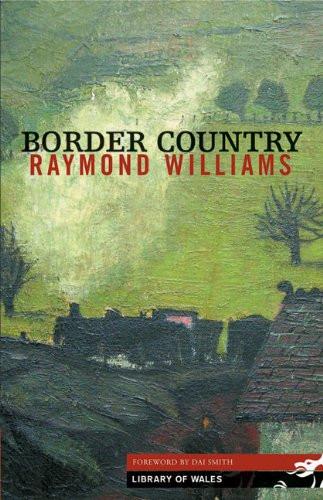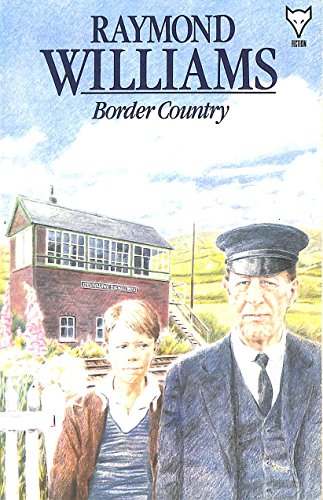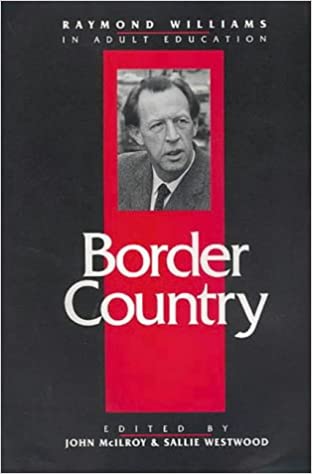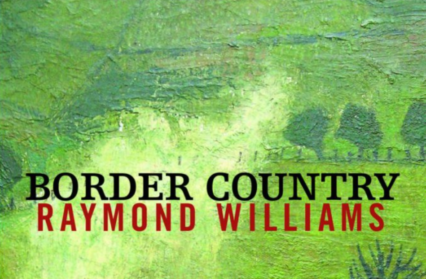In this first of a new set of articles, Wales Arts Review publishes introductory essays on the titles in the Library of Wales series of books, beginning at the beginning, with the first to be published, Raymond Williams’ Border Country.
The Library of Wales is a classics series celebrating the literary culture of Wales in the English Language primarily in the 20th century. It was launched in 2006 with five titles, So Long Hector Bebb, Border Country, Country Dance, The Dark Philosophers & Cwmardy. It has now fifty titles in the series with close to 100,000 books sold and can claim to have changed the perception of Welsh writing in English, reinvigorating the interest in classics such as Autobiography of a Super Tramp and Rhapsody, while bringing new light to titles that fallen from view such as Frank Richards’ memoir of army life in Old Soldiers Never Die and Leonora Brito’s Dat’s Love and other stories. Many of the titles are now being taught at university level while Poetry 1900 to 2000, an anthology edited by Meic Stephens has been added to the GCSE syllabus in Wales. The series has also inspired radio dramas, stage plays, art exhibitions and much political and cultural commentary. The Library of Wales 1 to 50 series was edited by Professor Dai Smith and published by Parthian.
Each book included an introduction giving us an opportunity to reconsider the series through an enthusiast’s eyes.

Border Country was first published in 1960. It was Raymond Williams’ first novel and can be seen as a fictional companion piece to his Culture and Society which had appeared in 1958. It’s themes of working-class family life and social organisation in the border country around Abergavenny in the 1930s has proved enduring and insightful. It is the most popular title to date in the Library of Wales with over 10,000 sales. The cover of the book is a painting of a steam train running thorough open country by Charles Burton. When the National Eisteddfod was held in Abergavenny in 2016 there were several art exhibitions inspired by the novel including In Raymond Williams’s Border Country curated by Peter Wakelin and introduced in Wales Arts Review here. It included work by John Elwyn and Joan Baker.
And the innovative Lost Library exhibition by Catherine Wynne-Paton held in Abergavenny Library and on the streets of the town. The book is widely studied at university level and the fabric of the novel is further discussed in the Literary Atlas of Wales.
The foreword is by the series editor Professor Dai Smith whose critically acclaimed biography Raymond Williams: A Warrior’s Tale appeared in 2008. His latest work of fiction is the novel The Crossing.
*
I first read Border Country when it appeared as a Penguin paperback in 1964. Its author was familiar to me for his pathbreaking critical studies Culture and Society (1958) and The Long Revolution (1961), but an undergraduate from the Rhondda at Oxford did not buy hardback novels, and I had only been made aware of the existence of Raymond Williams’ 1960 novel from biographical blurbs. I shelled out my five shillings and took it home. For me it crackled with the excitement of a discovery I had somehow known all along. I did not stop reading until, some time the next day, it was finished, and I have never stopped re-reading that original copy since. The hook for me was the instantly recognisable emotional and intellectual journey of a working-class boy who goes away from his shaping community. By the 1960s this had become a familiar pattern, one to be repeated for generations, but it was an experience originating directly, as occurred in Raymond Williams’ own life, from that first limited grammar-school exodus of the 1930s. This is still usually told as a story about successful individuals gratefully climbing ladders. Not so here – instead, with a subtlety of touch matched by an integrity of vision, the novel does what no history fully can do and little fiction has achieved: it shows the inescapable intertwining of individuals’ lives and social conditions in the fluidity of lived experience that we all share. Although you can approach Border Country in more than one way, the final route out will always be the same, for, as Matthew Price reflects at the end of the book’s odyssey: ‘The distance is measured, and that is what matters. By measuring the distance, we come home.’
Border Country is a deceptive novel. It grips us immediately with its story of one man running and never stopping, but from the first page it also asks the reader to think deeply about how we conceive our general history as a society. The style of Border Country is pared down, almost entirely pruned of similes and metaphors, and quietly serves its straightforward tale, but the novel is also clearly and defiantly proud to be so plain. It is patently a novel about Welsh people set in Wales, and it deals centrally with the myth and reality of the 1926 General Strike, as it was felt through Welsh history and in individual lives. Yet it is geographically marginal to those thunderous struggles in the coalfield, and its Welsh character is more locally rooted than nationally defined. On publication in 1960, this novel, which had been worked on since the late 1940s and was completed in 1958, seemed to some to be, in its dogged realism, past its time, but in its global relevance today it is more contemporary than ever.
 The novel is set in motion, from its very first sentence, with Matthew Price running for a bus in London. He is a university lecturer who is working on population movements in the industrialising valleys of South Wales in the nineteenth century. He is dissatisfied with the scholarly techniques he has learned to measure this human displacement and renewed settlement. The results have ‘the solidity and precision of ice cubes, while a given temperature is maintained.’ In actual life no such precision is possible. So what exactly is being measured? It is the overall picture, without which no change can be measured, but after which the real nature of existence has been lost: ‘The man on the bus, the man in the street, but I am Price from Glynmawr,’ Matthew muses to himself.
The novel is set in motion, from its very first sentence, with Matthew Price running for a bus in London. He is a university lecturer who is working on population movements in the industrialising valleys of South Wales in the nineteenth century. He is dissatisfied with the scholarly techniques he has learned to measure this human displacement and renewed settlement. The results have ‘the solidity and precision of ice cubes, while a given temperature is maintained.’ In actual life no such precision is possible. So what exactly is being measured? It is the overall picture, without which no change can be measured, but after which the real nature of existence has been lost: ‘The man on the bus, the man in the street, but I am Price from Glynmawr,’ Matthew muses to himself.
Raymond Williams from Pandy spent his lifetime working out how not to betray that individual essence whilst at the same time understanding its wider and connected cultural being. I believe he showed the way best in his fiction, where the journey is undertaken not in order to go back – for that is never possible – but in order to see how social renewal can occur as growth in human terms. Border Country is, therefore, concerned with both Space and Time as the twinned defining attributes of human communities.
The time-shifts move us from Matthew’s return – by train and car – to be with his dying father, Harry Price, railway signalman, to Harry’s own coming to Glynmawr with his young bride, Ellen, to work in the 1920s. It is the General Strike of 1926 that brings one form of self-definition to a head. In a number of brilliantly poised passages of dialogue, Raymond Williams takes his variously committed railway workers through the gradations of political commitment and self-sacrifice which weighted their act of solidarity with the locked-out miners with such profound social significance. Its meaning resonated as late as 1984, when the last industrial reference back to 1926 was made. And possibly, if we understand such support in terms of irreducible human values rather than political flotsam, it retains such meaning even beyond its particular time. Certainly that is how Williams would have us see it. His insistence is that it is only by contemplating how individual destiny interplays with wider forces, always experienced spatially, that we can makes sense of life in the human chronology of Price from Glynmawr. The alternative, and profoundly so, is submission to non-sense.
The novel’s most plangent tone is, in counterpoint then, a lyrical one. ‘I know this country,’ the writer informs us in the prefatory note to its first printing and we can easily see that he loved it too. Not as a landscape for tourist consumption but as a land made over and over, often with intense struggle between social classes as much as against nature, to create human habitation fit for the potential of always changing communities:
Once they were up on the road, Harry and Ellen could look out over the valley and the village in which they had come to live…
 The narrow road wound through the valley. The railway, leaving the cutting at the station, ran out north on an embankment, roughly parallel with the road but a quarter of a mile distant. Between road and railway, in its curving course, ran the Honddu, the black water. On the east of the road ran the grassed embankment of the old tramroad, with a few overgrown stone quarries near its line. The directions coincided, and Harry, as he walked, seemed to relax and settle. Walking the road in the October evening, they felt on their faces their own country: the huddled farmhouses, with their dirty yards; the dogs under the weed-growing walls; the cattle-marked crossing from the sloping field under the orchard; the long fields, in the line of the valley, where the cattle pastured; the turned red earth of the small, thickly-hedged ploughland; the brooks, alder-lined, curving and meeting; the bracken-heaped tussocky fields up the mountain, where the sheep were scattered under the wood-shaded barns; the occasional white wall, direct towards the sun, standing out where its windows caught the light across the valley; the high black line of the mountains, and the ring of the sheep wall.
The narrow road wound through the valley. The railway, leaving the cutting at the station, ran out north on an embankment, roughly parallel with the road but a quarter of a mile distant. Between road and railway, in its curving course, ran the Honddu, the black water. On the east of the road ran the grassed embankment of the old tramroad, with a few overgrown stone quarries near its line. The directions coincided, and Harry, as he walked, seemed to relax and settle. Walking the road in the October evening, they felt on their faces their own country: the huddled farmhouses, with their dirty yards; the dogs under the weed-growing walls; the cattle-marked crossing from the sloping field under the orchard; the long fields, in the line of the valley, where the cattle pastured; the turned red earth of the small, thickly-hedged ploughland; the brooks, alder-lined, curving and meeting; the bracken-heaped tussocky fields up the mountain, where the sheep were scattered under the wood-shaded barns; the occasional white wall, direct towards the sun, standing out where its windows caught the light across the valley; the high black line of the mountains, and the ring of the sheep wall.
The patch of eight houses lay ahead: set so that looking to the north and west the spurs of the mountains lay open in the distance. Harry stopped, put down the leather box, and looked around. ‘All right, last bit,’ he said after resting, and they went on to the houses.
Within its frame, then, of Time and Space, we share in and comprehend human endeavour and human growth and human loss. There is not a false or sentimental note anywhere in this book. Nothing is romanticised and nobody is idealised. We are never allowed to see what is local in action as being somehow limited in reach or implication. Raymond Williams fully understood that his country on the border was only different in its specific shapes, so that at someone else’s border, in the changing particularities of other histories of migration and settlement and struggle, the narrative, personal and general, continued.
I believe that Border Country is one of the most moving and accomplished novels of the twentieth century, written anywhere by anyone. In Wales, the fact that it was written by Williams from Pandy is an occasion for small, extra celebration. More importantly, in its new Library of Wales format, it deserves to go out more widely than ever into the world, so that by being measured it can properly come home to us again.
Raymond Williams was born in 1921 in the Welsh border village of Pandy. He taught at both Oxford and Cambridge, and in 1974 was appointed as Professor of Drama at Cambridge. His best-known publications include; Culture and Society (1958), The Long Revolution (1961), The Country and the City (1973), Keywords (1976) and Marxism and Literature (1977).
Dai Smith is a cultural historian, author, academic, and broadcaster.












